Synoptic and Mesoscale Analysis of a Severe Weather Event in Southern Brazil at the End of June 2020
Abstract
1. Introduction
2. Materials and Methods
2.1. Region of Study
2.2. Data
- (a)
- (b)
- For the synoptic analysis, standard time data (0000, 0006, 1200, and 1800 UTC) of geopotential height, zonal and meridional wind components, temperature, relative humidity, mean sea level pressure, sea surface temperature, and latent and sensible heat fluxes from ERA5 reanalysis [72], provided by the European Center for Medium-Range Weather Forecasts were obtained. ERA5 was downloaded with 0.25° × 0.25° horizontal resolution for the period from 28 June to 3 July of 2020. For the generation of satellite images, brightness temperature data from the infrared channel 13 (IR, 10.30 µm) of the Geostationary Operational Environmental Satellite-16 (GOES-16) were used. These data belong to the National Oceanic and Atmospheric Administration (NOAA) with a spatial resolution of 2 km and a temporal resolution of 10 min [73]. The data are reprocessed by the Center for Climate Studies and Weather Forecasting (CPTEC) from National Institute for Space Research (INPE) and freely available (http://ftp.cptec.inpe.br/goes/goes16/retangular/ (accessed on 25 November 2022). Satellite data are applied in both the synoptic and mesoscale analyses of this study;
- (c)
- (d)
- To estimate the physical properties of the squall line, reflectivity data from the Morro da Igreja radar were used. This weather radar operates in S-band radar (10 cm) frequency with temporal resolution of 10 min and 240 km distance range, and is located in the state of SC. The radar belongs to the Department of Airspace Control (DCEA) and is operated by the Aeronautics Command Meteorology Network [75]. A Constant Altitude Plan Position Indicator (CAPPI) with 1 km of vertical and horizontal resolution, from 3 to 15 km heights was produced;
- (e)
- The electrical activity of the squall line was evaluated using return stroke occurrence provided by the Brazilian Electrical Discharge Detection System—BrasilDAT [76,77] for 30 June 2020. This network is based on the technology of the Earth Network sensors and covers the south, southeast, midwest, and northeast regions of Brazil. It also employs the time-of-arrival method (TOA) and detects return flash emissions between 1 Hz and 12 MHz. The technology used by BrasilDAT allows discrimination between intracloud (IC) and cloud-to-ground (CG) return stroke, and the data are composed of the latitude, longitude, peak current, and other information of IC and CG return strokes. The total lightning was determined, which represents the sum of IC and CG lightning. This information was interpolated for a grid with 4 km spatial resolution. In addition, hourly accumulation of total lightning close to the region of the squall line was produced.
| Dataset | Horizontal Resolution | Frequency | Reference | Link to Access |
|---|---|---|---|---|
| ERA5 | 0.25° × 0.25° | Hourly | Herbach et al. (2020) [72] | https://cds.climate.copernicus.eu (accessed on 12 February 2022) |
| GFS | 0.25° × 0.25° | Hourly | GFS [74] | https://www.nco.ncep.noaa.gov/ (accessed on 12 February 2022) |
| REDEMET | 500 km (radius) | 10 min | REDEMET [75] | https://www.redemet.aer.mil.br/ (accessed on 12 February 2022) |
| GOES-16 | 2 km | 10 min | Minghelli et al. (2021) [73] | https://www.ngdc.noaa.gov/ (accessed on 22 November 2022) |
| BrasilDAT | Grid Point | nanoseconds | Naccarato and Machado (2019) [76] | http://www.inpe.br/webelat/ (accessed on 22 November 2022) |
| INMET | local | Hourly | INMET [71] | https://portal.inmet.gov.br/ (accessed on 12 February 2022) |
2.3. Synoptic Analysis
2.3.1. Cyclone Lifecycle
2.3.2. Explosive Cyclone
2.3.3. Frontogenetic Function
2.3.4. Atmospheric Fields
2.4. Physical Processes and Numerical Simulations
2.4.1. Model and Experiment Description
2.4.2. Sea–Air Interaction
2.5. Severe Weather/Mesoscale Convective Systems
3. Results
3.1. Synoptic Analysis
3.1.1. Physical Processes of Cyclogenesis
3.1.2. Explosive Phase
3.2. Sensitivity Experiments
3.3. Mesoscale Analysis and Physical Properties of the Squall Line
4. Conclusions
Author Contributions
Funding
Data Availability Statement
Acknowledgments
Conflicts of Interest
References
- Sanders, F.; Gyakum, J.R. Synoptic-dynamic climatology of the “bomb”. Mon. Weather Rev. 1980, 108, 1589–1606. [Google Scholar] [CrossRef]
- Zhang, S.; Fu, G.; Lu, C.; Liu, J. Characteristics of explosive cyclones over the Northern Pacific. J. Appl. Meteorol. Climatol. 2017, 56, 3187–3210. [Google Scholar] [CrossRef]
- NDMAIS. Ventos Durante o Cyclone Bomba em Santa Catarina Chegaram a 168 km/h Aponta Epagri. 2020. Available online: https://ndmais.com.br/tempo/velocidade-durante-o-ciclone-bomba-em-santa-catarina-chegou-a-168-km-h-aponta-epagri/ (accessed on 14 January 2022).
- Faria, L.F.; Reboita, M.S. Eventos Meteorológicos Associados ao Ciclone Explosivo Ocorrido em Junho de 2020 e Impactos Socioambientais no Estado de Santa Catarina. Geografia 2023, 48, 1–27. Available online: https://www.periodicos.rc.biblioteca.unesp.br/index.php/ageteo/article/view/16661/12645 (accessed on 24 February 2023).
- GZH. Jornal Digital Gaúcho. 2020. Available online: https://gauchazh.clicrbs.com.br/ambiente/noticia/2020/07/ (accessed on 23 February 2022).
- Gan, M.A.; Rao, V.B. Surface cyclogenesis over South America. Mon. Weather Rev. 1991, 119, 1293–1302. [Google Scholar] [CrossRef]
- Seluchi, M.E. Diagnóstico y pronóstico de situaciones sinópticas conducentes a ciclogénesis sobre el este de Sudamérica. Geofísica Int. 1995, 34, 171–186. Available online: http://132.248.182.214/index.php/RGI/article/view/737 (accessed on 23 February 2022).
- Hoskins, B.J.; Hodges, K.I. A new perspective on Southern Hemisphere storm tracks. J. Clim. 2005, 18, 4108–4129. [Google Scholar] [CrossRef]
- Reboita, M.S.; Da Rocha, R.P.; Ambrizzi, T.; Sugahara, S. South Atlantic Ocean cyclogenesis climatology simulated by regional climate model (RegCM3). Clim. Dyn. 2010, 35, 1331–1347. [Google Scholar] [CrossRef]
- De Jesus, E.M.; da Rocha, R.P.; Crespo, N.M.; Reboita, M.S.; Gozzo, L.F. Multi-model climate projections of the main cyclogenesis hot-spots and associated winds over the eastern coast of South America. Clim. Dyn. 2021, 56, 537–557. [Google Scholar] [CrossRef]
- Lim, E.P.; Simmonds, I. Explosive cyclone development in the Southern Hemisphere and a comparison with Northern Hemisphere events. Mon. Weather Rev. 2002, 130, 2188–2209. [Google Scholar] [CrossRef]
- Bluestein, H.B. Synoptic-Dynamic Meteorology in Midlatitudes: Observations and Theory of Weather Systems; Oxford University Press: New York, NY, USA, 1992; Volume 2. [Google Scholar]
- Andrade, H.N.; Nunes, A.B.; Teixeira, M.S. South Atlantic explosive cyclones in 2014–2015: Study employing NCEP2 and MERRA-2 reanalyses. An. Acad. Bras. Ciências. 2022, 94. [Google Scholar] [CrossRef]
- Avila, V.D.; Nunes, A.B.; Alves, R.C.M. Análise de um Caso de Ciclogênese Explosiva Ocorrido em 03/01/2014 no Sul do Oceano Atlântico. Rev. Bras. Geogr. Fís. 2016, 9, 1088–1099. [Google Scholar] [CrossRef]
- Necco, G.V. Comportamiento de Vortices Ciclonicos En El Area Sudamerica Durante El FGGE: Ciclogenegis. Meteorologica 1982, 13, 7–19. [Google Scholar]
- Necco, G.V. Comportamiento de Vortices Ciclonicos En El Area Sudamerica Durante El FGGE: Trayectorias y Desarrollos. Meteorologica 1982, 13, 21–34. [Google Scholar]
- Sinclair, M.R. Objective identification of cyclones and their circulation intensity, and climatology. Weather Forecast. 1997, 12, 595–612. [Google Scholar] [CrossRef]
- Vera, C.S.; Vigliarolo, P.K.; Berebery, E. Cold Season Synoptic-Scale Waves over Subtropical South America. Mon. Weather Rev. 2002, 130, 684–699. [Google Scholar] [CrossRef]
- Reboita, M.S.; Da Rocha, R.P.; Ambrizzi, T. Dynamic and Climatological Features of Cyclonic Developments over Southwestern South Atlantic Ocean; Veress, B., Szigethy, P., Eds.; Horizons in Earth Science Research; Nova Science Publishers: Hauppauge, Germany, 2012; pp. 135–160. [Google Scholar]
- Crespo, N.M.; da Rocha, R.P.; Sprenger, M.; Wernli, H. A potential vorticity perspective on cyclogenesis over centre-eastern South America. Int. J. Climatol. 2021, 41, 663–678. [Google Scholar] [CrossRef]
- Crespo, N.M.; Reboita, M.S.; Gozzo, L.F.; de Jesus, E.M.; Torres-Alavez, J.A.; Lagos-Zúñiga, M.Á.; da Rocha, R.P. Assessment of the RegCM4-CORDEX-CORE performance in simulating cyclones affecting the western coast of South America. Clim. Dyn. 2022, 1–19. [Google Scholar] [CrossRef]
- Reboita, M.S.; Reale, M.; da Rocha, R.P.; Giorgi, F. Future changes in the wintertime cyclonic activity over the CORDEX-CORE southern hemisphere domains in a multi-model approach. Clim. Dyn. 2021, 57, 1533–1549. [Google Scholar] [CrossRef]
- Reboita, M.S.; Crespo, N.M.; Torres, J.A.; Reale, M.; Porfírio da Rocha, R.; Giorgi, F.; Coppola, E. Future changes in winter explosive cyclones over the Southern Hemisphere domains from the CORDEX-CORE ensemble. Clim. Dyn. 2021, 57, 3303–3322. [Google Scholar] [CrossRef]
- Bitencourt, D.P.; Fuentes, M.V.; Cardoso, C.D.S. Climatology of explosive cyclones over cyclogenetic area of South America. Rev. Bras. Meteorol. 2013, 28, 43–56. [Google Scholar] [CrossRef]
- Fink, A.H.; Pohle, S.; Pinto, J.G.; Knippertz, P. Diagnosing the influence of diabatic processes on the explosive deepening of extratropical cyclones. Geophys. Res. Lett. 2012, 39. [Google Scholar] [CrossRef]
- Gozzo, L.F.; Rocha, R.P.D. Air–sea interaction processes influencing the development of a Shapiro–Keyser type cyclone over the subtropical South Atlantic Ocean. Pure Appl. Geophys. 2013, 170, 917–934. [Google Scholar] [CrossRef]
- Willison, J.; Robinson, W.A.; Lackmann, G.M. The importance of resolving mesoscale latent heating in the North Atlantic storm track. J. Atmos. Sci. 2013, 70, 2234–2250. [Google Scholar] [CrossRef]
- Neiman, P.J.; Shapiro, M.A. The life cycle of an extratropical marine cyclone. Part I: Frontal-cyclone evolution and thermodynamic air-sea interaction. Mon. Weather Rev. 1993, 121, 2153–2176. [Google Scholar] [CrossRef]
- Zhang, Y.; Held, I.M. A linear stochastic model of a GCM’s midlatitude storm tracks. J. Atmos. Sci. 1999, 56, 3416–3435. [Google Scholar] [CrossRef]
- Kouroutzoglou, J.; Flocas, H.A.; Hatzaki, M.; Keay, K.; Simmonds, I.; Mavroudis, A. On the dynamics of a case study of explosive cyclogenesis in the Mediterranean. Meteorol. Atmos. Phys. 2015, 127, 49–73. [Google Scholar] [CrossRef]
- Piva, E.; Gan, M.A.; Moscati, M.C.L. The role of latent and sensible heat fluxes in an explosive cyclogenesis over South America. J. Meteorol. Soc. Jpn. 2011, 89, 637–663. [Google Scholar] [CrossRef]
- Kang, J.M.; Son, S.W. Development Processes of the Explosive Cyclones over the Northwest Pacific: Potential Vorticity Tendency Inversion. J. Atmos. Sci. 2021, 78, 1913–1930. [Google Scholar] [CrossRef]
- Seluchi, M.E.; Saulo, A.C. Possible mechanisms yielding an explosive coastal cyclogenesis over South America: Experiments using a limited area model. Aust. Meteorol. Mag. 1998, 47, 309–320. [Google Scholar]
- Shapiro, M.A.; Keyser, D. Fronts, jet streams and the tropopause. In Extratropical Cyclones; American Meteorological Society: Boston, MA, USA, 1990; pp. 167–191. [Google Scholar] [CrossRef]
- Schultz, D.M.; Keyser, D.; Bosart, L.F. The effect of large-scale flow on low-level frontal structure and evolution in midlatitude cyclones. Mon. Weather Rev. 1998, 126, 1767–1791. [Google Scholar] [CrossRef]
- Reboita, M.S.; Gan, M.A.; Rocha RP, D.; Custódio, I.S. Ciclones em superfície nas latitudes austrais: Parte I-revisão bibliográfica. Rev. Bras. Meteorol. 2017, 32, 171–186. [Google Scholar] [CrossRef]
- Grønås, S. The seclusion intensification of the New Year’s day storm 1992. Tellus A 1995, 47, 733–746. [Google Scholar] [CrossRef]
- Brâncuş, M.; Schultz, D.M.; Antonescu, B.; Dearden, C.; Ştefan, S. Origin of strong winds in an explosive mediterranean extratropical cyclone. Mon. Weather Rev. 2019, 147, 3649–3671. [Google Scholar] [CrossRef]
- Cordeira, J.M.; Bosart, L.F. Cyclone interactions and evolutions during the “Perfect Storms” of late October and early November 1991. Mon. Weather Rev. 2011, 139, 1683–1707. [Google Scholar] [CrossRef]
- Reboita, M.S.; Gozzo, L.F.; Crespo, N.M.; Custodio, M.D.S.; Lucyrio, V.; de Jesus, E.M.; da Rocha, R.P. From a Shapiro–Keyser extratropical cyclone to the subtropical cyclone Raoni: An unusual winter synoptic situation over the South Atlantic Ocean. Q. J. R. Meteorol. Soc. 2022, 148, 2991–3009. [Google Scholar] [CrossRef]
- Bjerknes, J.; Solberg, H. Life cycle of cyclones and the polar front theory of atmospheric circulation. Geofys. Publ. 1922, 3, 3–18. [Google Scholar]
- Salio, P.; Nicolini, M.; Zipser, E.J. Mesoscale convective systems over southeastern South America and their relationship with the South American low-level jet. Mon. Weather Rev. 2007, 135, 1290–1309. [Google Scholar] [CrossRef]
- Yang, Q.; Houze, R.A., Jr.; Leung, L.R.; Feng, Z. Environments of long-lived mesoscale convective systems over the central United States in convection permitting climate simulations. J. Geophys. Res. Atmos. 2017, 122, 13–288. [Google Scholar] [CrossRef]
- Feng, Z.; Houze, R.A., Jr.; Leung, L.R.; Song, F.; Hardin, J.C.; Wang, J.; Homeyer, C.R. Spatiotemporal characteristics and large-scale environments of mesoscale convective systems east of the Rocky Mountains. J. Clim. 2019, 32, 7303–7328. [Google Scholar] [CrossRef]
- Schumacher, R.S.; Rasmussen, K.L. The formation, character and changing nature of mesoscale convective systems. Nat. Rev. Earth Environ. 2020, 1, 300–314. Available online: https://www.nature.com/articles/s43017-020-0057-7 (accessed on 23 February 2023). [CrossRef]
- Li, J.; Feng, Z.; Qian, Y.; Leung, L.R. A high-resolution unified observational data product of mesoscale convective systems and isolated deep convection in the United States for 2004–2017. Earth Syst. Sci. Data 2021, 13, 827–856. [Google Scholar] [CrossRef]
- Lin, Y.L. Mesoscale Instabilities. In Mesoscale Dynamics Cambridge; Cambridge University Press: Cambridge, UK, 2007; pp. 229–271. [Google Scholar] [CrossRef]
- Lima, K.B.; Aquino, F.E.; Moraes, D.S.; Palhoça, S.C. Impactos gerados por dois Complexos Convectivos de Mesoescala de diferentes extensões no sul do Brasil. Rev. Gestão Sustentabilidade Ambient. 2018, 7, 186–205. Available online: http://hdl.handle.net/10183/223089 (accessed on 23 February 2023). [CrossRef]
- Moraes, F.D.; Aquino, F.E.; Mote, T.L.; Durkee, J.D.; Mattingly, K.S. Atmospheric characteristics favorable for the development of mesoscale convective complexes in southern Brazil. Clim. Res. 2020, 80, 43–58. [Google Scholar] [CrossRef]
- McNulty, R.P. Severe and Convective Weather: A Central Region Forecasting Challenge. Weather Forecast. 1995, 10, 187–202. [Google Scholar] [CrossRef]
- Bluestein, H.B.; Jain, M.H. Formation of mesoscale lines of precipitation: Severe squall lines in Oklahoma during the spring. J. Atmos. Sci. 1985, 42, 1711–1732. [Google Scholar] [CrossRef]
- Lemon, L.R.; Doswell, I.I.I. CA Severe thunderstorm evolution and mesocyclone structure as related to tornadogenesis. Mon. Weather Rev. 1979, 107, 1184–1197. [Google Scholar] [CrossRef]
- Silva Dias, M.A.F. Mesoscale systems and short-term weather forecasting. Rev. Bras. Meteorol. 1987, 2, 133–150. [Google Scholar]
- Ribeiro, B.Z.; Seluchi, M.E. A climatology of quasi-linear convective systems and associated synoptic-scale environments in southern Brazil. Int. J. Climatol. 2019, 39, 857–877. [Google Scholar] [CrossRef]
- Dorneles, V.R.; Riquetti, N.B.; Nunes, A. Forçantes dinâmicas e térmicas associadas a um caso de precipitação intensa sobre o Rio Grande do Sul, Brasil. Rev. Bras. Climatol. 2020, 26. [Google Scholar] [CrossRef]
- Thompson, R.L.; Edwards, R.; Hart, J.A.; Elmore, K.L.; Markowski, P. Close proximity soundings within supercell environments obtained from the Rapid Update Cycle. Weather Forecast. 2003, 18, 1243–1261. [Google Scholar] [CrossRef]
- Dupilka, M.L.; Reuter, G.W. Forecasting tornadic thunderstorm potential in Alberta using environmental sounding data. Part I: Wind shear and buoyancy. Weather Forecast. 2006, 21, 325–335. [Google Scholar] [CrossRef]
- Kolendowicz, L.; Taszarek, M.; Czernecki, B. Atmospheric circulation and sounding-derived parameters associated with thunderstorm occurrence in Central Europe. Atmos. Res. 2017, 191, 101–114. [Google Scholar] [CrossRef]
- Houze, R.A.; Smull, B.F.; Dodge, P. Mesoscale organization of springtime rainstorms in Oklahoma. Mon. Weather Rev. 1990, 118, 613–654. [Google Scholar] [CrossRef]
- Browning, K.A. Conceptual models of precipitation systems. Weather Forecast. 1986, 1, 23–41. [Google Scholar] [CrossRef]
- Schemm, S.; Wernli, H. The linkage between the warm and the cold conveyor belts in an idealized extratropical cyclone. J. Atmos. Sci. 2014, 71, 1443–1459. [Google Scholar] [CrossRef]
- Cotton, W.R.; Anthes, R.A. Storm and Cloud Dynamics; Elsevier: Amsterdam, The Netherlands, 2013; Volume 44. [Google Scholar]
- Neu, U.; Akperov, M.G.; Bellenbaum, N.; Benestad, R.; Blender, R.; Caballero, R.; Wernli, H. IMILAST: A community effort to intercompare extratropical cyclone detection and tracking algorithms. Bull. Am. Meteorol. Soc. 2013, 94, 529–547. [Google Scholar] [CrossRef]
- Liberato, M.L.R.; Pinto, J.G.; Trigo, R.M.; Ludwig, P.; Ordóñez, P.; Yuen, D.; Trigo, I.F. Explosive development of winter storm Xynthia over the subtropical North Atlantic Ocean. Nat. Hazards Earth Syst. Sci. 2013, 13, 2239–2251. [Google Scholar] [CrossRef]
- Pinto, R.; Martins, F.C. The Portuguese national strategy for integrated coastal zone management as a spatial planning instrument to climate change adaptation in the Minho River Estuary (Portugal NW-Coastal Zone). Environ. Sci. Policy 2013, 33, 76–96. [Google Scholar] [CrossRef]
- Gaztelumendi, S.; Egaña, J.; Gelpi, I.R.; Carreño, S.; Gonzalez, M.; Liria, P.; Aranda, J.A. Characterization of coastal-maritime severe events in Basque Country. In Proceedings of the 7th EuroGOOS Conference, Lisboa, Portugal, 28–30 October 2014; Volume 2830. [Google Scholar]
- Gaztelumendi, S.; Egaña, J.; Gelpi, I.R.; Carreño, S.; González, M.; Liria, P.; Esnaola, G.; Rubio, A.; Aranda, J.A. Analysis of Coastal-Maritime Adverse Events in Basque Country. In Proceedings of the 14th EMS 10th ECAC, Prague, Czech Republic, 6–10 October 2014; Available online: https://presentations.copernicus.org/EMS2014-450_presentation.pdf (accessed on 23 February 2023).
- Reale, M.; Liberato, M.L.; Lionello, P.; Pinto, J.G.; Salon, S.; Ulbrich, S. A global climatology of explosive cyclones using a multi-tracking approach. Tellus A Dyn. Meteorol. Oceanogr. 2019, 71, 1611340. [Google Scholar] [CrossRef]
- Allen, J.T.; Pezza, A.B.; Black, M.T. Explosive cyclogenesis: A global climatology comparing multiple reanalyses. J. Clim. 2010, 23, 6468–6484. [Google Scholar] [CrossRef]
- Kuwano-Yoshida, A.; Enomoto, T. Predictability of explosive cyclogenesis over the northwestern Pacific region using ensemble reanalysis. Mon. Weather Rev. 2013, 141, 3769–3785. [Google Scholar] [CrossRef]
- Instituto Nacional De Meteorologia (INMET). Dados Meteorológicos. Banco de Dados Meteorológicos. 2022. Available online: https://bdmep.inmet.gov.br/ (accessed on 2 March 2022).
- Hersbach, H.; Bell, B.; Berrisford, P.; Biavati, G.; Dee, D.; Horányi, A.; Nicolas, J.; Peubey, C.; Radu, R.; Rozum, I.; et al. The ERA5 Global Atmospheric Reanalysis at ECMWF as a comprehensive dataset for climate data homogenization, climate variability, trends and extremes. Geophys. Res. Abstr. 2019, 21. Available online: https://ui.adsabs.harvard.edu/abs/2019EGUGA..2110826H/abstract (accessed on 23 February 2023).
- Minghelli, A.; Chevalier, C.; Descloitres, J.; Berline, L.; Blanc, P.; Chami, M. Synergy between Low Earth Orbit (LEO)—MODIS and Geostationary Earth Orbit (GEO)—GOES Sensors for Sargassum Monitoring in the Atlantic Ocean. Remote Sens. 2021, 13, 1444. [Google Scholar] [CrossRef]
- Global Forecast System—GFS. Available online: https://www.ncei.noaa.gov/products/weather-climate-models/global-forecast (accessed on 10 January 2022).
- Redemet. Brazilian Air Force. Brazil. Available online: https://www.redemet.aer.mil.br/ (accessed on 3 July 2020).
- Naccarato, K.; Machado, L. Brazil BrasilDAT Lightning Network Data. Version 1.0. UCAR/NCAR—Earth Observing Laboratory. 2019. Available online: https://doi.org/10.26023/N9QW-SAKN-R311 (accessed on 23 December 2022).
- Mattos, E.V.; Reboita, M.S.; Llopart, M.P.; Enoré, D.P. Análise Sinótica e Caracterização Física de uma Tempestade Intensa Ocorrida na Região de Bauru-SP. Anuário Inst. Geociências 2020, 43, 85–106. [Google Scholar] [CrossRef]
- Dacre, H.F.; Hawcroft, M.K.; Stringer, M.A.; Hodges, K.I. An extratropical cyclone atlas: A tool for illustrating cyclone structure and evolution characteristics. Bull. Am. Meteorol. Soc. 2012, 93, 1497–1502. [Google Scholar] [CrossRef]
- Sanders, F. Explosive cyclogenesis in the west-central North Atlantic Ocean, 1981–1984. Part I: Composite structure and mean behavior. Mon. Weather Rev. 1986, 114, 1781–1794. [Google Scholar] [CrossRef]
- Petterssen, S. Contribution to the Theory of Frontogenesis. In Cammermeyer in Komm; 1936; Volume 11, Available online: http://www.ngfweb.no/docs/NGF_GP_Vol11_no6.pdf (accessed on 11 September 2022).
- Skamarock, W.C.; Klemp, J.B.; Dudhia, J.; Gill, D.O.; Liu, Z.; Berner, J.; Huang, X.Y. A Description of the Advanced Research WRF Model Version 4; National Center for Atmospheric Research: Boulder, CO, USA, 2019; p. 145. Available online: https://www.ucar.edu/ (accessed on 30 June 2021).
- Thompson, G.; Field, P.R.; Rasmussen, R.M.; Hall, W.D. Explicit forecasts of winter precipitation using an improved bulk microphysics scheme. Part II: Implementation of a new snow parameterization. Mon. Weather Rev. 2008, 136, 5095–5115. [Google Scholar] [CrossRef]
- Hong, S.Y.; Noh, Y.; Dudhia, J. A new vertical diffusion package with an explicit treatment of entertainment processes. Mon. Weather Rev. 2006, 134, 2318–2341. [Google Scholar] [CrossRef]
- Janjić, Z.I. Comments on “Development and evaluation of a convection scheme for use in climate models. J. Atmos. Sci. 2000, 57, 3686. [Google Scholar] [CrossRef]
- Dudhia, J. Numerical study of convection observed during the winter monsoon experiment using a mesoscale two-dimensional model. J. Atmos. Sci. 1989, 46, 3077–3107. [Google Scholar] [CrossRef]
- Mlawer, E.J.; Taubman, S.J.; Brown, P.D.; Iacono, M.J.; Clough, S.A. Radiative transfer for inhomogeneous atmospheres: RRTM, a validated correlated-k model for the longwave. J. Geophys. Res. Atmos. 1997, 102, 16663–16682. [Google Scholar] [CrossRef]
- Kain, J.S.; Fritsch, J.M. Convective parameterization for mesoscale models: The Kain-Fritsch scheme. In The representation of cumulus convection in numerical models. Am. Meteorol. Soc. 1993, 165–170. [Google Scholar] [CrossRef]
- Betts, A.K.; Miller, M.J. The Betts-Miller scheme. In The Representation of Cumulus Convection in Numerical Models; Springer: Boston, MA, USA, 1993; pp. 107–121. [Google Scholar] [CrossRef]
- Janić, Z.I. Nonsingular Implementation of the Mellor-Yamada Level 2.5 Scheme in the NCEP Meso Model. 2001. Available online: https://repository.library.noaa.gov/view/noaa/11409 (accessed on 10 July 2022).
- Large, W.G.; Pond, S. Sensible and latent heat flux measurements over the ocean. J. Phys. Oceanogr. 1982, 12, 464–482. [Google Scholar] [CrossRef]
- Buttar, N.A.; Hu, Y.; Tanny, J.; Raza, A.; Niaz, Y.; Khan, M.I.; Bilal Idrees, M. Estimation of Sensible and Latent Heat Fluxes Using Flux Variance Method under Unstable Conditions: A Case Study of Tea Plants. Atmosphere 2022, 13, 1545. [Google Scholar] [CrossRef]
- World Meteorological Organization. 2021: Guide to Instruments and Methods of Observation–Measurement of Meteorological Variables. World Meteorological Organization (WMO): Geneva, Switzerland, 2021; Volume 1. [Google Scholar]
- Wallace, J.M.; Hobbs, P.V. Atmospheric Science: An Introductory Survey; Elsevier: Amsterdam, The Netherlands, 2006; Volume 92. [Google Scholar]
- Gan, M.A.; Reboita, M.S. Cyclogenesis and Extra-Tropical Cyclones Over Southeastern South America. 2016. Available online: https://resources.eumetrain.org/satmanu/CM4SH/BrCg/index.htm (accessed on 23 June 2022).
- Gramcianinov, C.B.; Hodges, K.I.; Camargo, R.D. The properties and genesis environments of South Atlantic cyclones. Clim. Dyn. 2019, 53, 4115–4140. [Google Scholar] [CrossRef]
- Kuo, Y.H.; Shapiro, M.A.; Donall, E.G. The interaction between baroclinic and diabatic processes in a numerical simulation of a rapidly intensifying extratropical marine cyclone. Mon. Weather Rev. 1991, 119, 368–384. [Google Scholar] [CrossRef]
- Miller, D.K.; Katsaros, K.B. Satellite-derived surface latent heat fluxes in a rapidly intensifying marine cyclone. Mon. Weather Rev. 1992, 120, 1093–1107. [Google Scholar] [CrossRef]
- Reed, R.J.; Albright, M.D.; Sammons, A.J.; Undén, P. The role of latent heat release in explosive cyclogenesis: Three examples based on ECMWF operational forecasts. Weather. Forecast 1988, 3, 217–229. [Google Scholar] [CrossRef]
- Ren, X.; Perrie, W.; Long, Z.; Gyakum, J. Atmosphere–ocean coupled dynamics of cyclones in the midlatitudes. Mon. Weather Rev. 2004, 132, 2432–2451. [Google Scholar] [CrossRef]
- Heo, K.Y.; Seo, Y.W.; Ha, K.J.; Park, K. Development mechanisms of an explosive cyclone over East Sea on 3–4 April 2012. Dyn. Atmos. Ocean. 2015, 70, 30–46. [Google Scholar] [CrossRef]
- Schmetz, J.; Tjemkes, S.A.; Gube, M.; Van de Berg, L. Monitoring deep convection and convective overshooting with METEOSAT. Adv. Space Res. 1997, 19, 433–441. [Google Scholar] [CrossRef]
- Hidayat, A.M.; Efendi, U.; Rahmadini, H.N.; Nugraheni, I.R. The Characteristics of squall line over Indonesia and its vicinity based on Himawari-8 satellite imagery and radar data interpretation. IOP Conf. Ser. Earth Environ. Sci. 2019, 303, 012059. [Google Scholar] [CrossRef]
- Greene, D.R.; Clark, R.A. Vertically integrated liquid water—A new analysis tool. Mon. Weather Rev. 1972, 100, 548–552. [Google Scholar] [CrossRef]
- Mattos, E.V.; Machado, L.A.; Williams, E.R.; Goodman, S.J.; Blakeslee, R.J.; Bailey, J.C. Electrification life cycle of incipient thunderstorms. J. Geophys. Res. Atmos. 2017, 122, 4670–4697. [Google Scholar] [CrossRef]
- Abreu, E.X.; Vieira Mattos, E.; Banda Sperling, V. Caracterização das Assinaturas de Radar e da Atividade Elétrica de Relâmpagos de Tempestades com Granizo no Estado de São Paulo. Anuário Inst. Geociências 2020, 43, 173–188. [Google Scholar]
- Zhang, J.; Langston, C.; Howard, K. Brightband identification based on vertical profiles of reflectivity from the WSR-88D. J. Atmos. Ocean. Technol. 2008, 25, 1859–1872. [Google Scholar] [CrossRef]
- Waldvogel, A.; Federer, B.; Grimm, P. Criteria for the detection of hail cells. J. Appl. Meteorol. Climatol. 1979, 18, 1521–1525. [Google Scholar] [CrossRef]
- Rinehart, R.E. Radar for Meteorologist Fifth Edition; Rinehart Publications: Nevada, Missouri, 2010. [Google Scholar]
- Straka, J.M.; Zrnić, D.S.; Ryzhkov, A.V. Bulk hydrometeor classification and quantification using polarimetric radar data: Synthesis of relations. J. Appl. Meteorol. 2000, 39, 1341–1372. [Google Scholar] [CrossRef]
- Medina, B.L.; Machado, L.A. Dual polarization radar Lagrangian parameters: A statistics-based probabilistic nowcasting model. Nat. Hazards 2017, 89, 705–721. [Google Scholar] [CrossRef]
- Chronis, T.; Carey, L.D.; Schultz, C.J.; Schultz, E.V.; Calhoun, K.M.; Goodman, S.J. Exploring lightning jump characteristics. Weather Forecast. 2015, 30, 23–37. [Google Scholar] [CrossRef]
- Williams, N.J.; Jaramillo, P.; Taneja, J. An investment risk assessment of microgrid utilities for rural electrification using the stochastic techno-economic microgrid model: A case study in Rwanda. Energy Sustain. Dev. 2018, 42, 87–96. [Google Scholar] [CrossRef]
- Lopes, C.D.C. Microfísica, Cinemática e Eletrificação em Tempestades Tropicais que Geraram granizo Durante o Projeto SOS-CHUVA. Doctoral Dissertation, Universidade de São Paulo, São Paulo, Brazil, 2019. Available online: https://doi.org/10.11606/D.14.2019.tde-06052019-155657 (accessed on 23 August 2022). [CrossRef]
- Fujita, T. Precipitation and cold air production in mesoscale thunderstorm systems. J. Atmos. Sci. 1959, 16, 454–466. [Google Scholar] [CrossRef]
- Zipser, E.J. Mesoscale and convective–scale downdrafts as distinct components of squall-line structure. Mon. Weather Rev. 1977, 105, 1568–1589. [Google Scholar] [CrossRef]
- Varble, A.; Morrison, H.; Zipser, E. Effects of under-resolved convective dynamics on the evolution of a squall line. Mon. Weather Rev. 2020, 148, 289–311. [Google Scholar] [CrossRef]
- Zhang, M. An Analytical Model of Two-Dimensional Mesoscale Circulation and Associated Properties Across Squall Lines. AGU Adv. 2022, 3, e2022AV000726. [Google Scholar] [CrossRef]
- Coniglio, M.C.; Stensrud, D.J.; Wicker, L.J. Effects of upper-level shear on the structure and maintenance of strong quasi-linear mesoscale convective systems. J. Atmos. Sci. 2006, 63, 1231–1252. [Google Scholar] [CrossRef]
- Richardson, Y.P. The Influence of Horizontal Variations in Vertical Shear and Low-Level Moisture on Numerically Simulated Convective Storms; The University of Oklahoma: Norman, OK, USA, 1999. [Google Scholar]
- Alfaro, D.A.; Khairoutdinov, M. Thermodynamic constraints on the morphology of simulated midlatitude squall lines. J. Atmos. Sci. 2015, 72, 3116–3137. [Google Scholar] [CrossRef]
- Alfaro, D.A. Low-tropospheric shear in the structure of squall lines: Impacts on latent heating under layer-lifting ascent. J. Atmos. Sci. 2017, 74, 229–248. [Google Scholar] [CrossRef]
- Taylor, C.M.; Belušić, D.; Guichard, F.; Parker, D.J.; Vischel, T.; Bock, O.; Harris, P.P.; Janicot, S.; Klein, C.; Panthou, G. Frequency of extreme Sahelian storms tripled since 1982 in satellite observations. Nature 2017, 544, 475–478. [Google Scholar] [CrossRef] [PubMed]
- Taylor, C.M.; Fink, A.H.; Klein, C.; Parker, D.J.; Guichard, F.; Harris, P.P.; Knapp, K.R. Earlier seasonal onset of intense mesoscale convective systems in the Congo Basin since 1999. Geophys. Res. Lett. 2018, 45, 13–458. [Google Scholar] [CrossRef]
- Klein, C.; Nkrumah, F.; Taylor, C.M.; Adefisan, E.A. Seasonality and trends of drivers of mesoscale convective systems in southern West Africa. J. Clim. 2021, 34, 71–87. [Google Scholar] [CrossRef]
- Mulholland, J.P.; Peters, J.M.; Morrison, H. How does vertical wind shear influence entrainment in squall lines? J. Atmos. Sci. 2021, 78, 1931–1946. [Google Scholar] [CrossRef]
- Held, G.; van den Berg, H.J.C. A pre-frontal squall line on 14 November 1975. Arch. Meteorol. Geophys. Bioklimatol. 1977, 26, 361–379. [Google Scholar] [CrossRef]
- Zhang, D.L.; Fritsch, J.M. Numerical simulation of the meso-β scale structure and evolution of the 1977 Johnstown flood. Part I: Model description and verification. J. Atmos. Sci. 1986, 43, 1913–1944. [Google Scholar] [CrossRef]
- Johns, R.H.; Hirt, W.D. Derechos: Widespread convectively induced windstorms. Weather Forecast. 1987, 2, 32–49. [Google Scholar] [CrossRef]
- Van Delden, A. The synoptic setting of a thundery low and associated prefrontal squall line in western Europe. Meteorol. Atmos. Phys. 1988, 65, 113–131. [Google Scholar] [CrossRef]
- Ahrens, C.D.; Henson, R. Essentials of Meteorology: An Invitation to the Atmosphere; Cengage Learning: Boston, MA, USA, 2016. [Google Scholar]
- Williams, E.R. The Electrification of Severe Storms. In Severe Convective Storms; Doswell, C.A., Ed.; Meteorological Monographs; American Meteorological Society: Boston, MA, USA, 2001. [Google Scholar] [CrossRef]
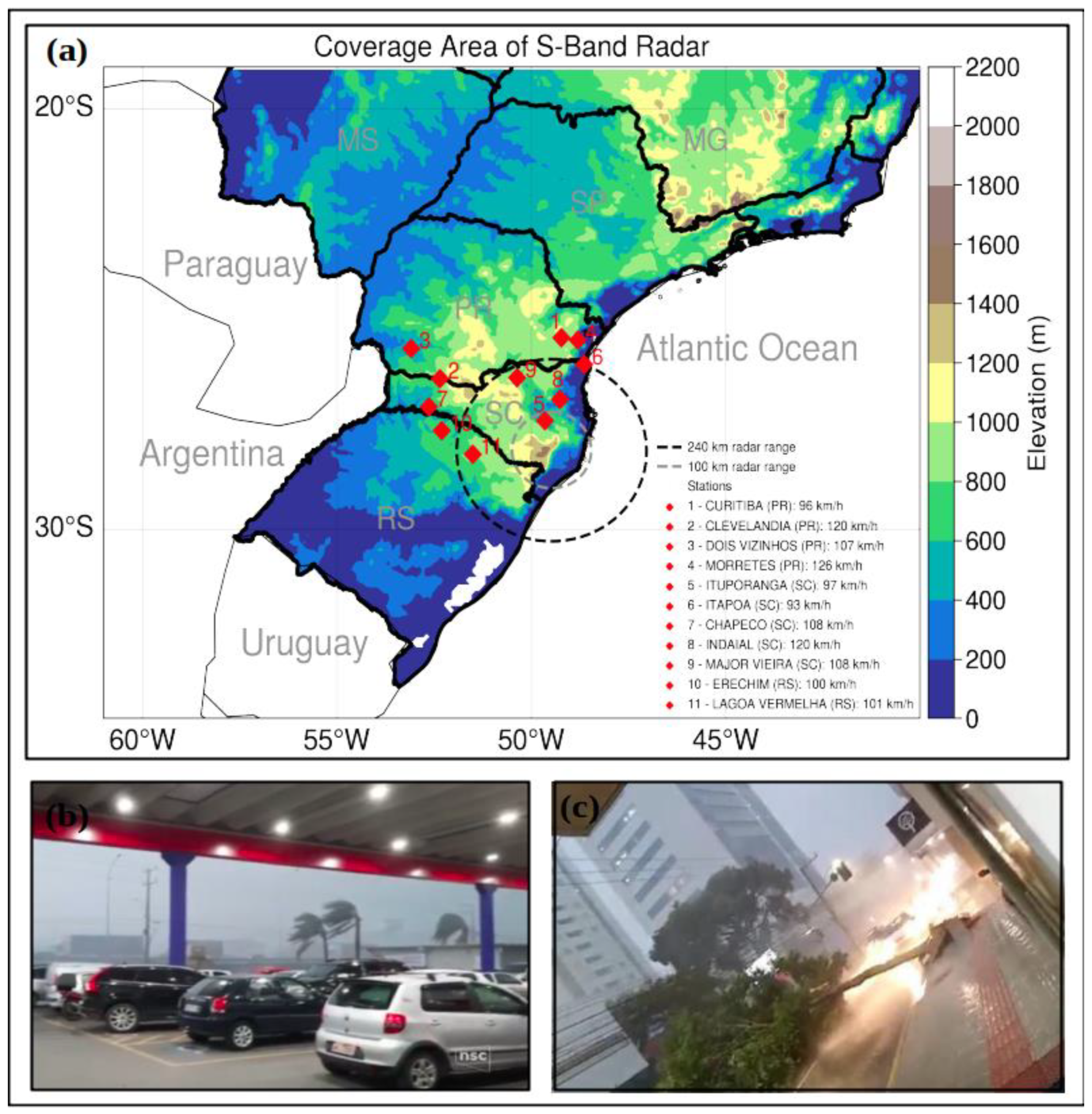

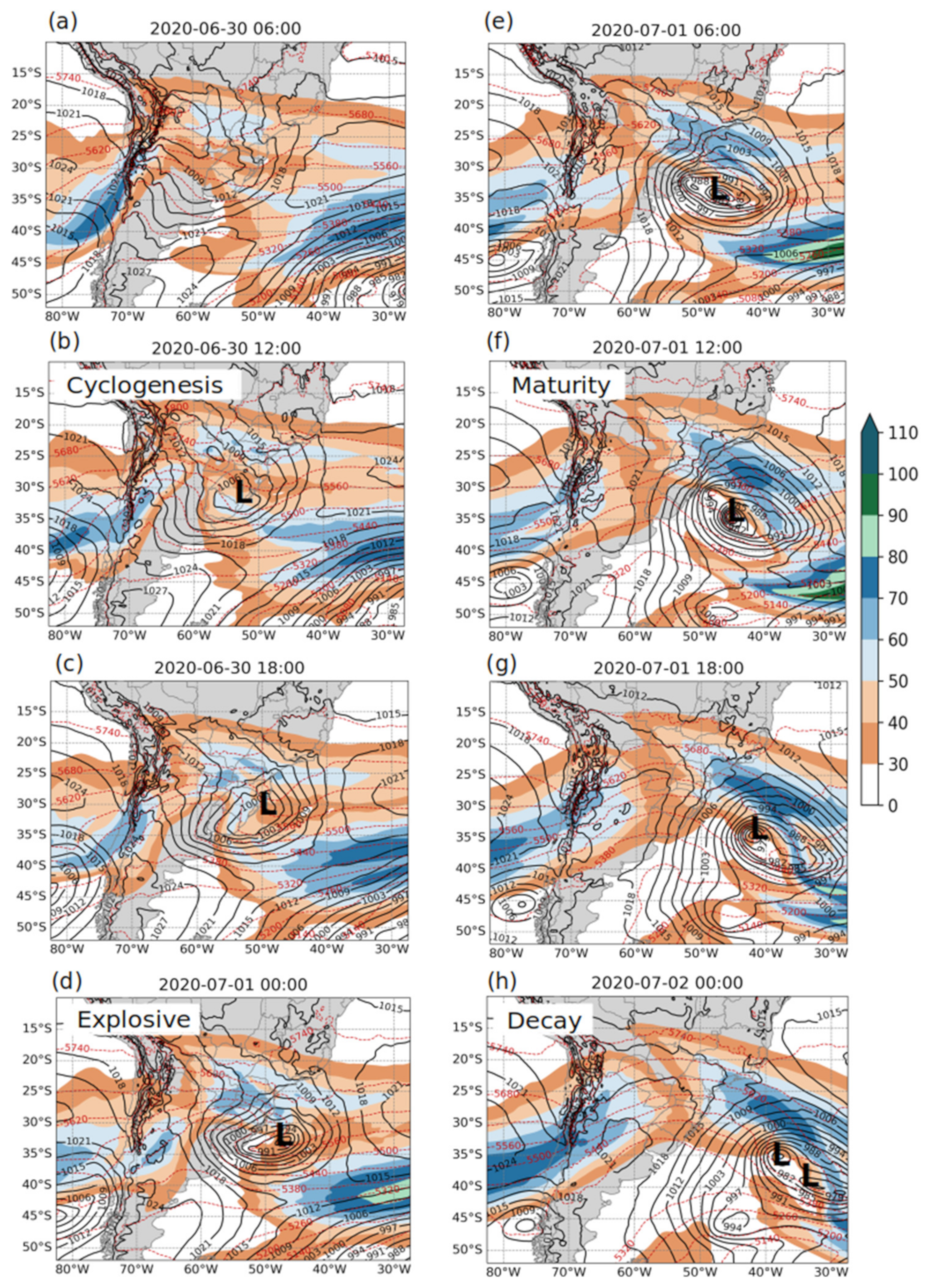
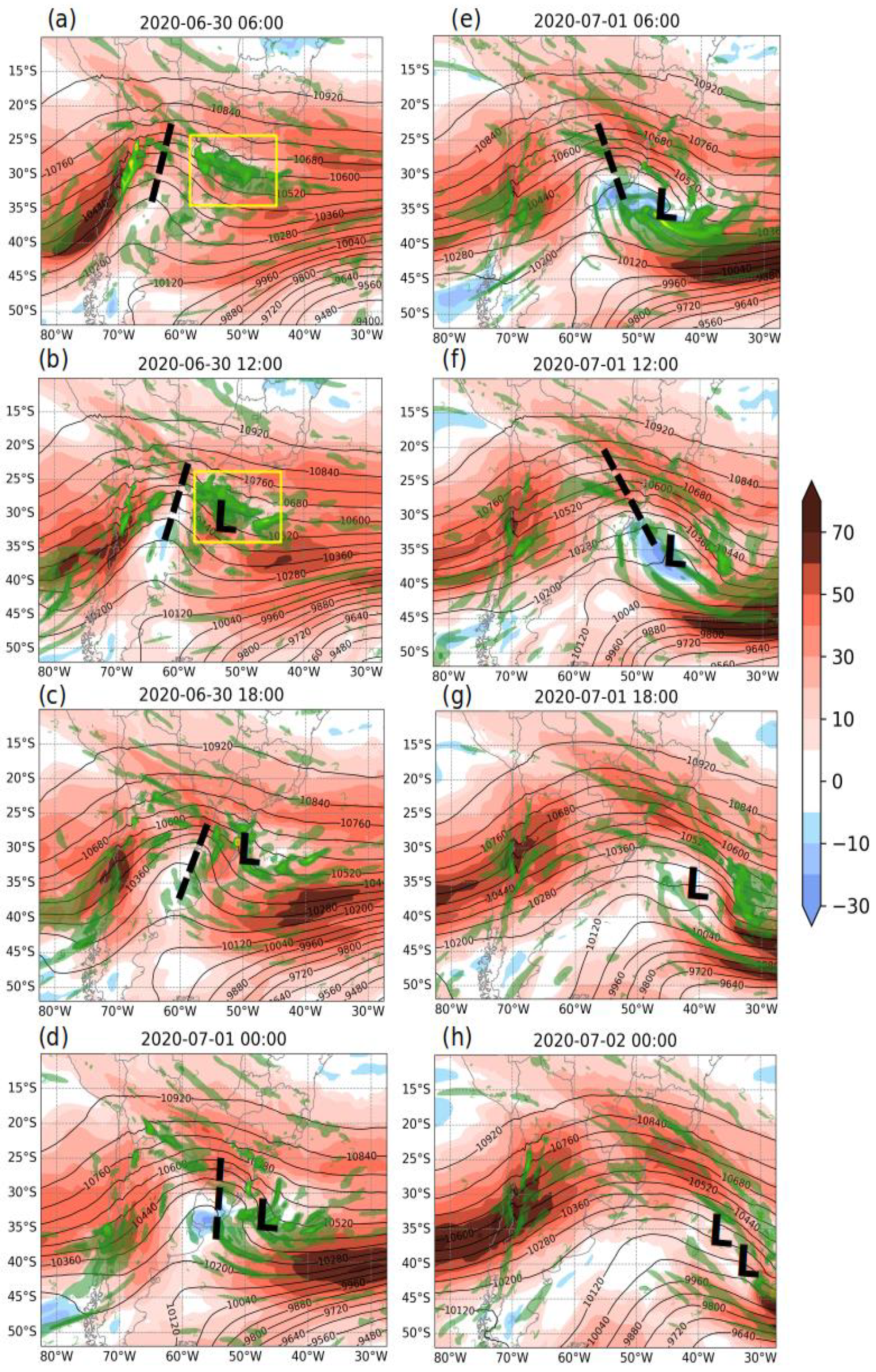
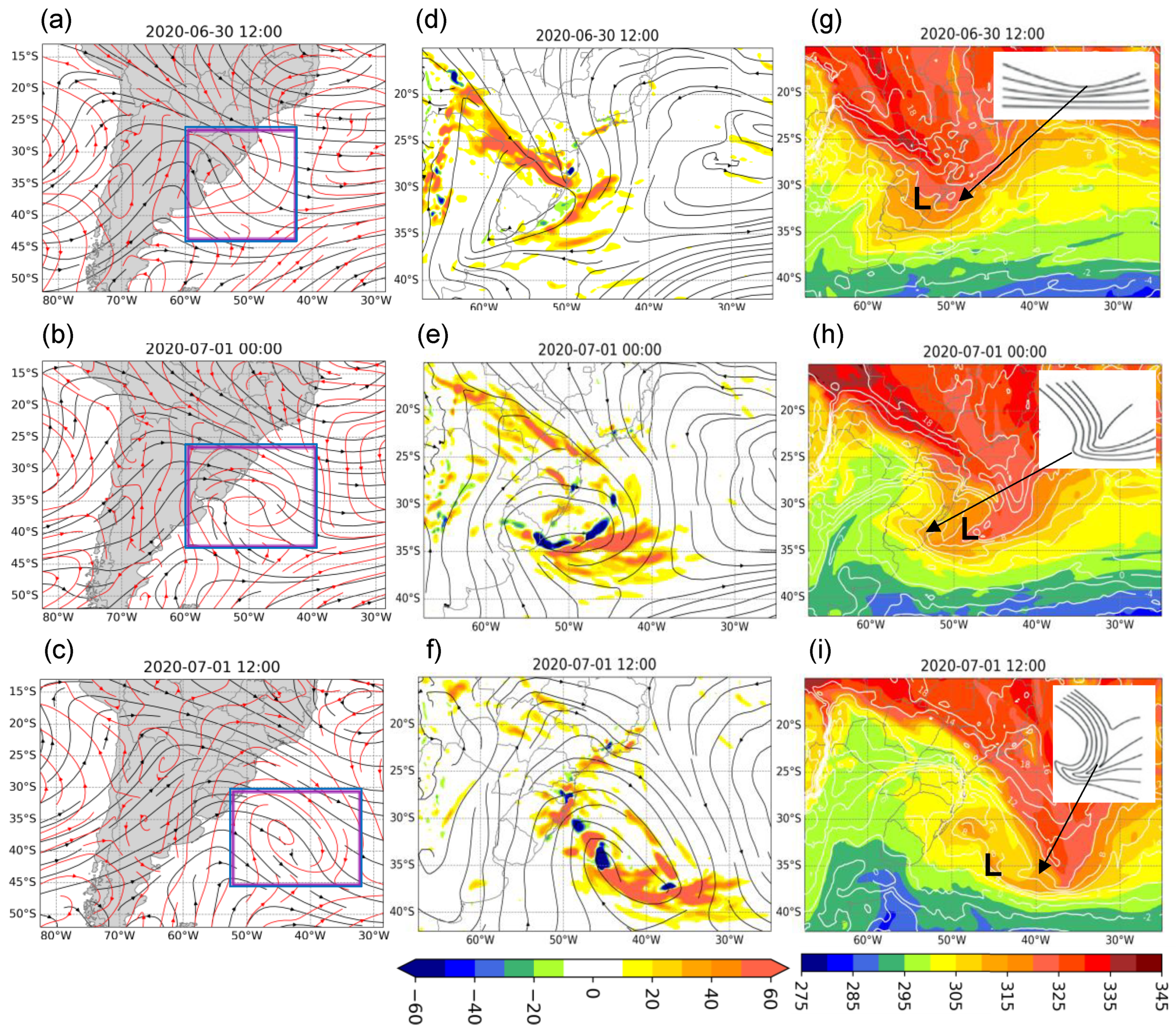
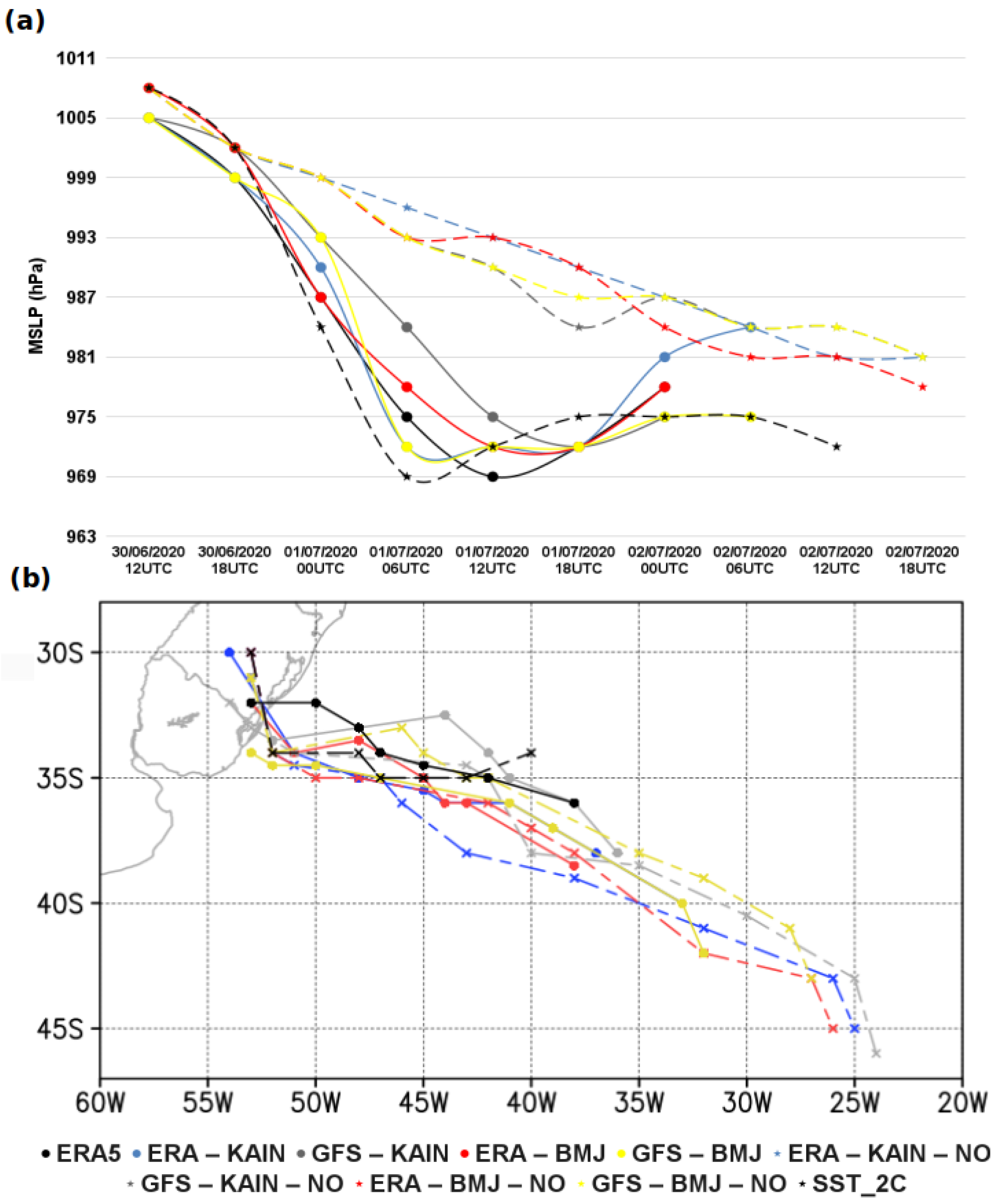

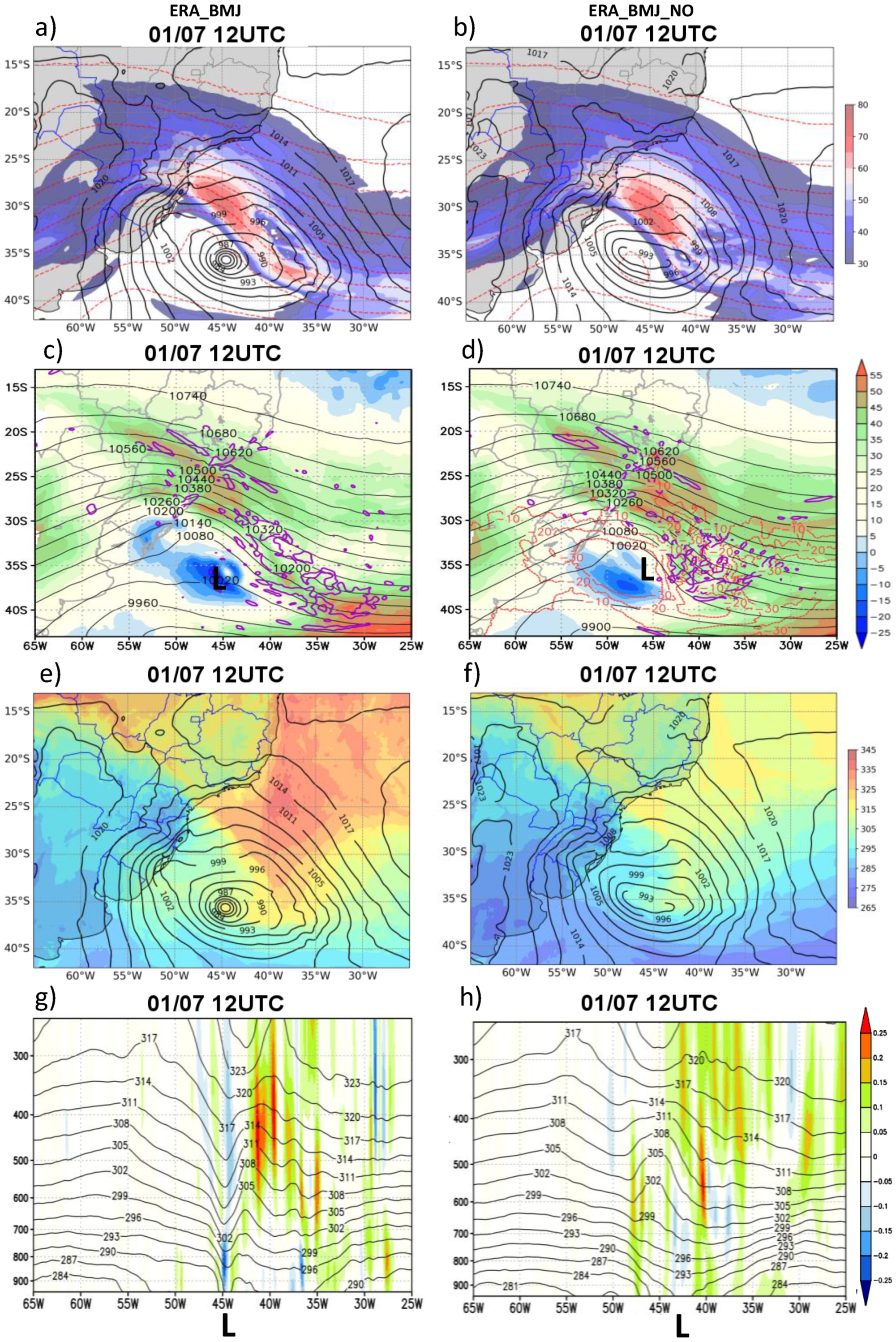
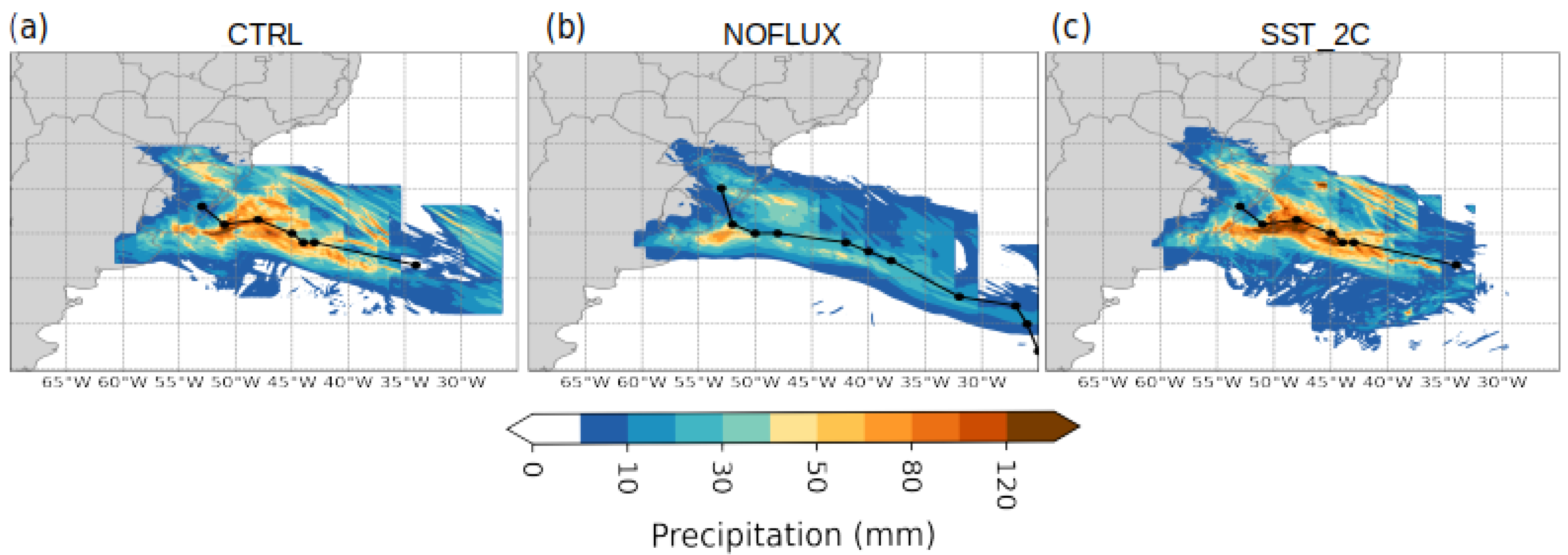

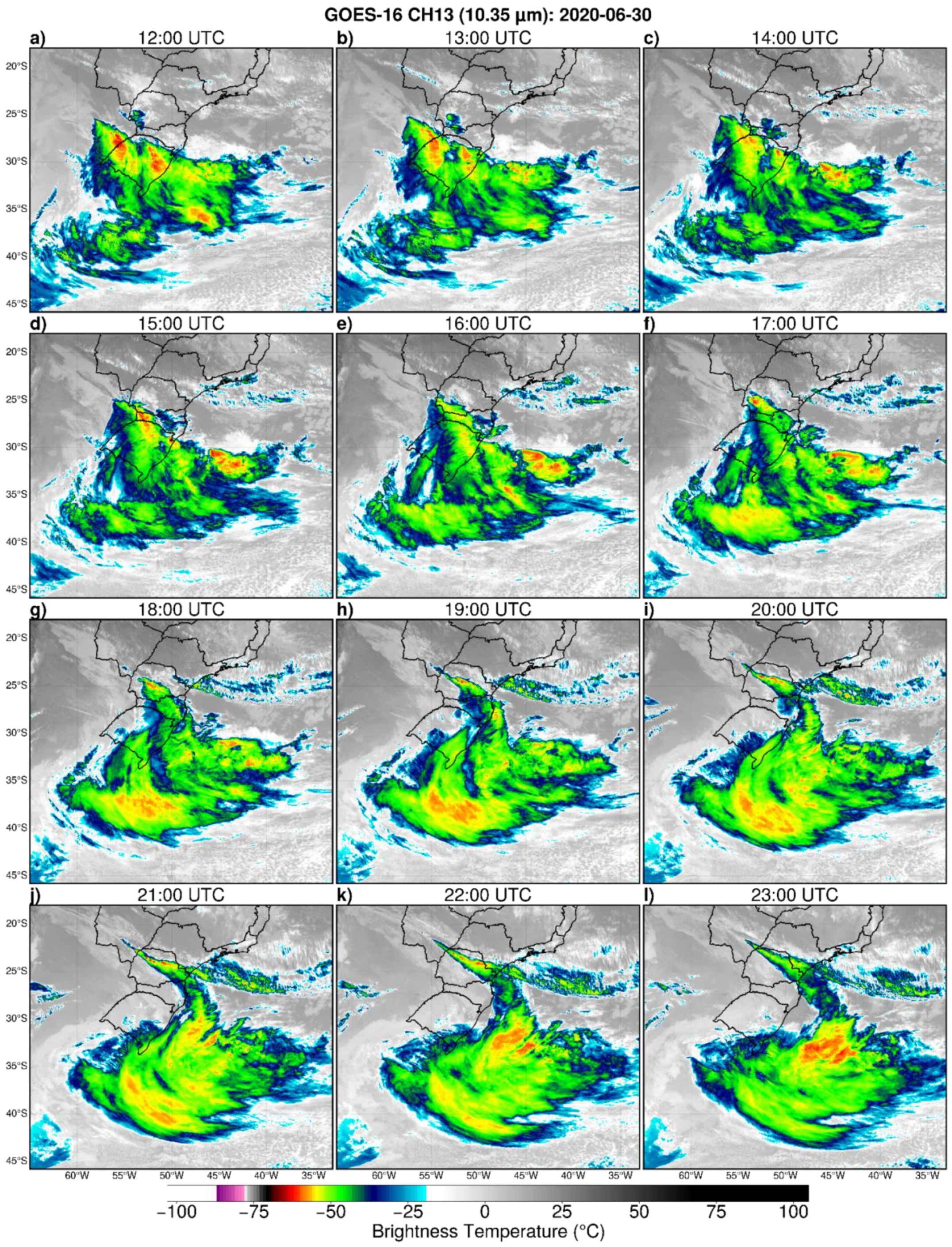
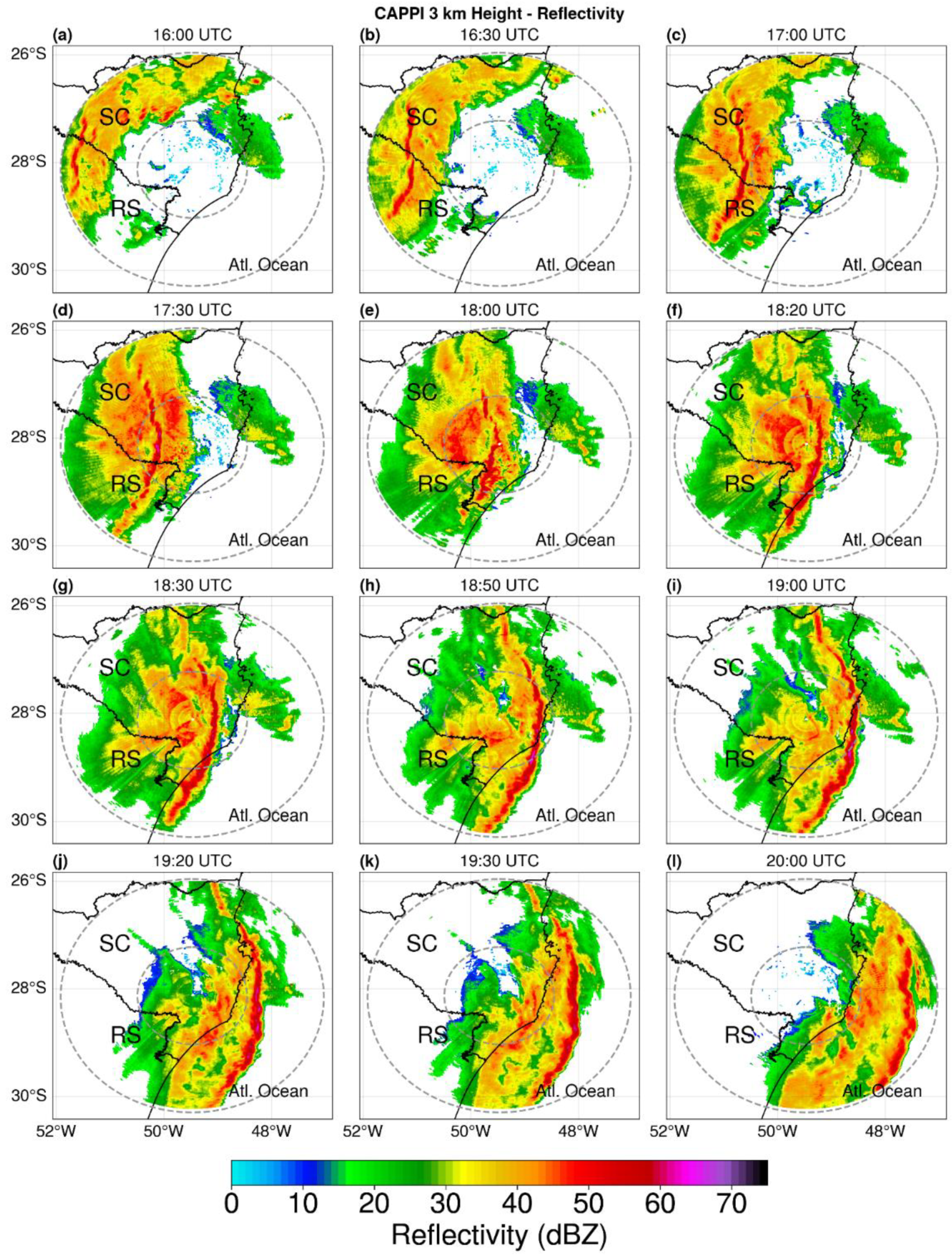



| Experiment | Boundary Conditions | SST | Cumulus Convection | Fluxes |
|---|---|---|---|---|
| ERA_KAIN | ERA | Normal | KF | ON |
| ERA_BMJ | ERA | Normal | BMJ | ON |
| GFS_KAIN | GFS | Normal | KF | ON |
| GFS_BMJ | GFS | Normal | BMJ | ON |
| ERA_KAIN_NO | ERA | Normal | KF | OFF |
| ERA_BMJ_NO | GFS | Normal | BMJ | OFF |
| GFS_KAIN_NO | GFS | Normal | KF | OFF |
| GFS_BMJ_NO | GFS | Normal | BMJ | OFF |
| SST_2C | ERA | +2 °C | BMJ | ON |
| Date | Hour | Lat | Lon | MSLP | NDRt24 | NDRt12 |
|---|---|---|---|---|---|---|
| 30/06 Genesis | 1200 | −32 | −56 | 1006 | - | - |
| 30/06 | 1800 | −30 | −50 | 1000 | - | - |
| 01/07 Explosive | 0000 | −33 | −47 | 988 | - | 1.9474 (strong) |
| 01/07 | 0600 | −34 | −47 | 976 | - | 2.5966 (super) |
| 01/07 Maturity | 1200 | −34 | −45 | 969 | 2.3851 (strong) | 1.9474 (strong) |
| 01/07 | 1800 | −35 | −42 | 973 | 1.7888 (moderate) | 0.3245 |
| 02/07 Decay | 0000 | −38 | −35 | 979 | 0.5962 | −0.9737 |
| Experiment | Cyclogenesis Date | Cyclolysis Date | Cyclogenesis Pressure (hPa) | Lifetime (Hours) | Traveled Distance (km) |
|---|---|---|---|---|---|
| ERA5 | 30/06 1200 UTC | 02/07 0000 UTC | 1005 | 36 | 1666 |
| ERA_KAIN | 30/06 1200 UTC | 02/07 0600 UTC * | 1005 | 40 | 1888 |
| ERA_BMJ | 30/06 1200 UTC | 02/07 0000 UTC * | 1005 | 36 | 1666 |
| GFS_KAIN | 30/06 1200 UTC | 02/07 1200 UTC * | 1005 | 36 | 2111 |
| GFS_BMJ | 30/06 1200 UTC | 02/07 0600 UTC * | 1005 | 40 | 2333 |
| ERA_KAIN_NO | 30/06 1200 UTC | 02/07 1800 UTC | 1008 | 52 | 3111 |
| ERA_BMJ_NO | 30/06 1200 UTC | 02/07 1800 UTC | 1008 | 52 | 2999 |
| GFS_KAIN_NO | 30/06 1200 UTC | 02/07 1800 UTC | 1008 | 52 | 3222 |
| GFS_BMJ_NO | 30/06 1200 UTC | 02/07 1800 UTC | 1008 | 52 | 2888 |
| SST_2C | 30/06 1200 UTC | 02/07 1200 UTC | 1008 | 46 | 1444 |
Disclaimer/Publisher’s Note: The statements, opinions and data contained in all publications are solely those of the individual author(s) and contributor(s) and not of MDPI and/or the editor(s). MDPI and/or the editor(s) disclaim responsibility for any injury to people or property resulting from any ideas, methods, instructions or products referred to in the content. |
© 2023 by the authors. Licensee MDPI, Basel, Switzerland. This article is an open access article distributed under the terms and conditions of the Creative Commons Attribution (CC BY) license (https://creativecommons.org/licenses/by/4.0/).
Share and Cite
Fortunato de Faria, L.; Reboita, M.S.; Mattos, E.V.; Carvalho, V.S.B.; Martins Ribeiro, J.G.; Capucin, B.C.; Drumond, A.; Paes dos Santos, A.P. Synoptic and Mesoscale Analysis of a Severe Weather Event in Southern Brazil at the End of June 2020. Atmosphere 2023, 14, 486. https://doi.org/10.3390/atmos14030486
Fortunato de Faria L, Reboita MS, Mattos EV, Carvalho VSB, Martins Ribeiro JG, Capucin BC, Drumond A, Paes dos Santos AP. Synoptic and Mesoscale Analysis of a Severe Weather Event in Southern Brazil at the End of June 2020. Atmosphere. 2023; 14(3):486. https://doi.org/10.3390/atmos14030486
Chicago/Turabian StyleFortunato de Faria, Leandro, Michelle Simões Reboita, Enrique Vieira Mattos, Vanessa Silveira Barreto Carvalho, Joao Gabriel Martins Ribeiro, Bruno César Capucin, Anita Drumond, and Ana Paula Paes dos Santos. 2023. "Synoptic and Mesoscale Analysis of a Severe Weather Event in Southern Brazil at the End of June 2020" Atmosphere 14, no. 3: 486. https://doi.org/10.3390/atmos14030486
APA StyleFortunato de Faria, L., Reboita, M. S., Mattos, E. V., Carvalho, V. S. B., Martins Ribeiro, J. G., Capucin, B. C., Drumond, A., & Paes dos Santos, A. P. (2023). Synoptic and Mesoscale Analysis of a Severe Weather Event in Southern Brazil at the End of June 2020. Atmosphere, 14(3), 486. https://doi.org/10.3390/atmos14030486










